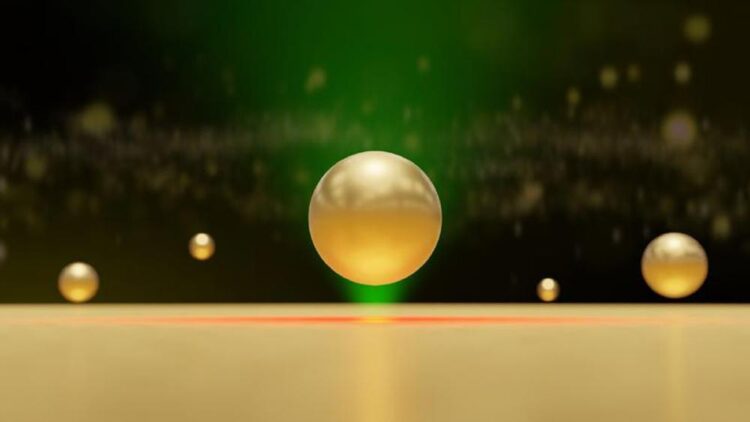Scientists develop new thermofluidic process for lab-on-a-chip applications

Illustration of a gold nanoparticle trapped near a locally heated gold surface by hydrodynamic and van der Waals forces.
(c) Martin Fränzl / Universität Leipzig
Researchers at Leipzig University have succeeded in moving tiny amounts of liquid at will by remotely heating water over a metal film with a laser. The currents generated in this way can be used to manipulate and even capture tiny objects. This will unlock groundbreaking new solutions for nanotechnology, the manipulation of liquids in systems in tiny spaces, or in the field of diagnostics, by making it possible to detect the smallest concentrations of substances with new types of sensor systems. In an article recently published in the high-impact journal “Nature Communications”, is described how this was achieved.
Flow generation is important at all scales – for transporting fluids in pipes, nutrients in blood vessels or chemicals in microfluidic systems for chemical processing and analysis. In almost all of these cases, the flow is the result of a difference in pressure that drives the fluid through these channels. These uncontrolled flows are not very useful when it comes to moving objects in solution, such as in the production of new functional materials, or transporting minute amounts of material to tiny, highly sensitive sensor elements. “They all move objects at the same speed along the vessel walls, and that’s why it is difficult in microfluidics to bring molecules to sensory elements or to assemble objects using these flows,” said Martin Fränzl, who worked on the project as a doctoral researcher.
Martin Fränzl and Professor Frank Cichos have now found that they can generate very strong fluid flows even in the tiniest of channels by heating a very thin metal film on one side of the channel with a focused laser beam. The flows originate in an ultra-thin liquid layer just a few nanometres above the surface of the metal and mix the liquid in the channel with a specific flow pattern. Fränzl measured this flow pattern using nanoparticles as tracers. Not only have the scientists succeeded in exploring the origin of these currents, but they have also shown that they can capture, separate or transport nano-objects by cleverly combining currents and controlling other forces remotely by laser.
“This is fascinating,” said Fränzl, “because it allows us to control how objects and fluids move at the nanoscale without moving the entire fluid in the channels.” Similar approaches are already being used in a project run by the joint Transregio / Collaborative Research Centre 102 at the Martin Luther University Halle-Wittenberg and Leipzig University to study the formation of protein aggregates involved in the development of neurodegenerative diseases.
Both researchers are particularly interested in combining these laser-driven thermofluidics with machine learning techniques in order to create automated smart nanofactories – for nanoscale manufacturing, programmed material manipulation and sensor technologies – that optimise and adapt to new requirements based on the information they collect.
“We believe that thermofluidics will help us develop new technologies and solutions that may be highly useful for new collaborative projects such as the µChem initiative, which combines physics, chemistry, biochemistry and artificial intelligence in microenvironments,” said Professor Detlev Belder from the Institute of Analytical Chemistry at Leipzig University’s Faculty of Chemistry and Mineralogy. This paves the way for lab-on-a-chip applications.
The method was developed in collaboration with b-ACTmatter, the Interfaculty Centre for Bioactive Matter, which is being funded under the federal programme STARK. STARK was set up to promote the transformation process in coal regions. b-ACTmatter aims to develop new materials and technologies that contribute to an innovative, sustainable and circular development of the economy.
Wissenschaftliche Ansprechpartner:
Professor Frank Cichos
Molecular Nanophotonics
Peter Debye Institute for Soft Matter Physics
Leipzig University
Phone:+49 341 97-32571
cichos@physik.uni-leipzig.de
Dr Susanne Ebitsch
Interfaculty Centre for Bioactive Matter b-ACT matter
Phone:+49 341 97-31387
susanne.ebitsch@bact.uni-leipzig.de
Originalpublikation:
M. Fränzl and F. Cichos: “Hydrodynamic manipulation of nano-objects by optically induced thermo-osmotic flows” Nature Communications”
DOI:10.1038/s41467-022-28212-z
Media Contact
All latest news from the category: Process Engineering
This special field revolves around processes for modifying material properties (milling, cooling), composition (filtration, distillation) and type (oxidation, hydration).
Valuable information is available on a broad range of technologies including material separation, laser processes, measuring techniques and robot engineering in addition to testing methods and coating and materials analysis processes.
Newest articles

Bringing bio-inspired robots to life
Nebraska researcher Eric Markvicka gets NSF CAREER Award to pursue manufacture of novel materials for soft robotics and stretchable electronics. Engineers are increasingly eager to develop robots that mimic the…

Bella moths use poison to attract mates
Scientists are closer to finding out how. Pyrrolizidine alkaloids are as bitter and toxic as they are hard to pronounce. They’re produced by several different types of plants and are…

AI tool creates ‘synthetic’ images of cells
…for enhanced microscopy analysis. Observing individual cells through microscopes can reveal a range of important cell biological phenomena that frequently play a role in human diseases, but the process of…





















